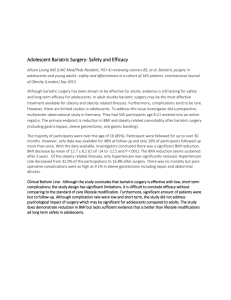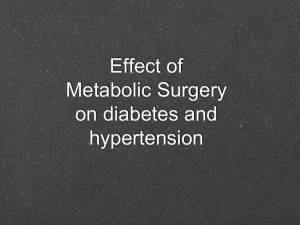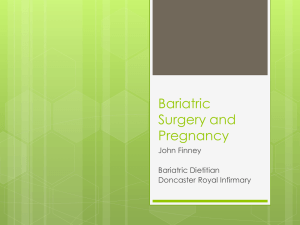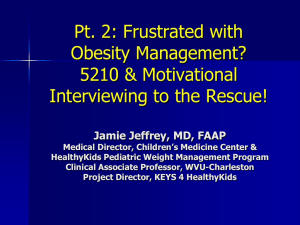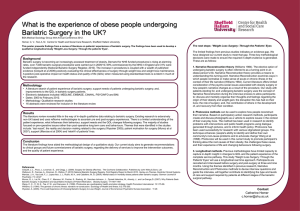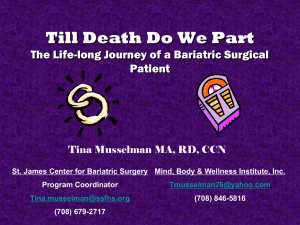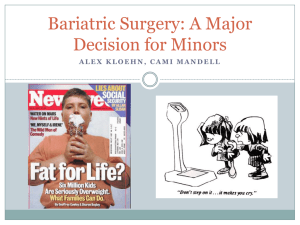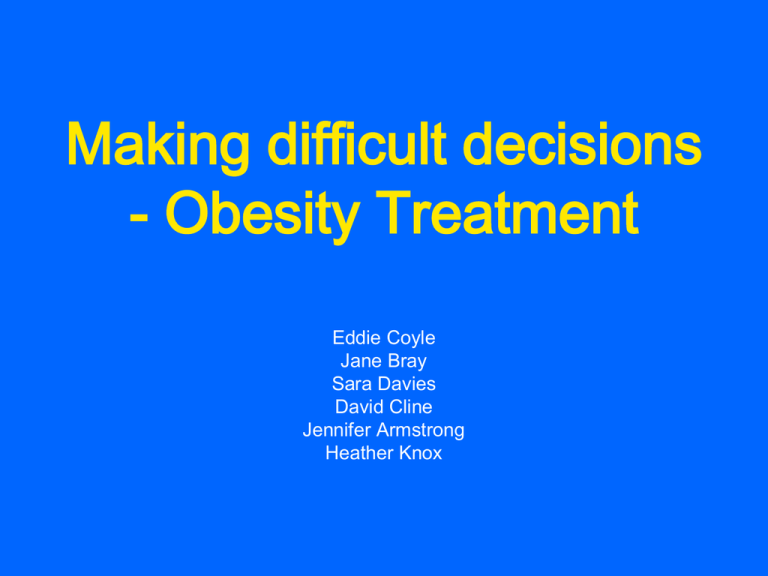
Making difficult decisions
- Obesity Treatment
Eddie Coyle
Jane Bray
Sara Davies
David Cline
Jennifer Armstrong
Heather Knox
Background
• National Planning Forum (NPF) requested by
Scottish Government’s Route Map to establish a
subgroup to provide advice on how NHS
Scotland should respond to growing demand for
bariatric surgery, including need for weight
management.
• OTS set up June ’10
• Membership: clinicians, public health, SG,
planners, QIS, primary care, patient reps,
ethicist
Obesity Treatment Subgroup
( NPF OTS)
Remit:
• Inform prioritisation of planning provision of
treatment for severe and complex obesity in
adults
Working methods:
• Evidence gathering from experts; review of
research evidence including cost effectiveness;
development of range of options for NPF and
board Chief Executives to consider.
Obesity Facts
• Scotland has second highest prevalence of obesity in the
world at 27% (1.1 million people)
• 8.4% population BMI ≥ 35 (347,000)
• 2.4% population BMI ≥ 40 (103,000)
• Epidemic expected to peak at 40% (2030)
• Severe obesity prevalence is increasing at 5% per year
• 50% of all obese people have significant health problems - comorbidities
Obesity Pathway
‘route map’
• Tier 1
Population-wide health
improvement work
• Tier 2
Primary care e.g. Counterweight
• Tier 3
Specialist Weight Management
» Management of severe and complex patients
» Gatekeeper for surgery
• Tier 4
Specialised surgical service
» Ante and post surgery
» Actual operations
Evidence Base: Tier 3 specialist
weight management
• Weight management is clinically effective
compared to no treatment (5kg, 2-4 yrs)
• Cost effectiveness evidence is limited, but
suggests cost effectiveness
• Small weight loss of <5kg can reduce comorbidities such as diabetes
Evidence base: Tier 4 Bariatric
surgery
• Bariatric surgery is highly clinically
effective and cost effective for achieving
wt loss (25-75 kg, 2-4 yrs)
• 75% of initial wt loss sustained at 10 years
• Cost effectiveness is greatest for BMI>40
or BMI 35-40+comorbidity
• £1,400 per QALY at 20yrs for BMI 30-40
and diabetes
Needs Assessment: Tier 3 Weight
Management
• Variable provision across Scotland
• Estimated population need 200550/100,000
• Essential both for
– treating obesity not managed in primary care
– and to provide support mechanism to manage
demand for surgery
Comparative numbers (rates) of
bariatric surgery
• Sweden: 4,879 (52.7/100,000)
• England: 6,520 (10.6/100,000)
• Scotland: 197 (4.6/100,000)
NPF/OTS: Evidence Summary
Outcomes:
• Strongest evidence for bariatric surgery £1400 - £4000 per QALY at 20 years
(T2DM and BMI 30-40; or BMI>40)
• Evidence of clinical effectiveness for Tier 3
but little on cost effectiveness
NPF/OTS: Pre Surgery Principles
• Build on existing services
• Tier 2 – in all NHS Boards
• Tier 3 – consider different models (could be shared
provision across boards; use of existing staff would reduce costs)
• Referral to Bariatric assessment from T3
– Success weight loss is criteria
NPF/OTS: Bariatric surgery
• ‘Ante’ and ‘post’ Bariatric with the surgical service
• Clear pre and post assessment and management
protocols
• Concentrate in centres with at least 2 surgeons with
minimum of 20 cases each per year with networking
• Audit: equity, access, outcomes
• Revisit by April 2013
Tier 4 Bariatric surgery - models
•
Seminar required – NPF/OTS - to get buy in to
evidence and agree models, due to varied
opinions of planners, clinicians and particular
concerns re-financial impact.
The 3 models are :
1. “Framework without criteria”
2. “Framework with topped criteria”
3. “Framework plus Type 2 Diabetes”
-
3B = Modified with tighter criteria
All models can be flexed to address case by case
Obesity Options: criteria and estimated demand
Option 1
“Framework without criteria”
- BMI >35
- Age ≥18
- At least one co-morbidity
43,182
No
Minimise
risk?
Yes
Option 2
“Framework with topped criteria”
- Age 18-44 years
- BMI 35-50 BMI
- At least one co-morbidity.
16,740
No
Prioritise
T2DM?
Yes
Option 3
“Framework plus Type 2 DM”
- Recent (< 5 years) onset of Type 2 diabetes
mellitus, in addition to Option 2 age/BMI criteria
625
BMI 35-39 = 375
BMI 40-50 = 250
Table 1 : Estimated impact of models
(bariatric surgery only)
Impacts for
Scotland on
adult population
Current
practice
Procedures
in 2009/10
Option 1
Option 2
Option 3
Option 3B
Framework
without
criteria
Framework
with
topped
criteria
CriteriaT2DM
Modified
criteria for
Option 3 –
BMI 35-39
Number of
patients
197
43,182
16,740
625
375
Rate /100,000
4.6
1,000
388
14.5
9
£1-2.2
million
£215-492
million
£83-191
million
£3-7 million
£1.9-4.2
million
Cost range
(band & bypass)
Summary
Primary care and specialist weight management services
– Primary care services in all health board areas
– Tier 3: As local as possible but cross Board provision should be
explored
– Use existing staff and consider role of technology
Surgery
– pre and post surgery weight management services should be colocated with surgery in centres with at least 40 cases per year and
2 surgeons
– Criteria with case by case flexibility
Outcome: NPF/OTS
• Planning principles agreed
• Preferred option – option 3B i.e. smallest
numbers (important to emphasise that this
recommendation includes increase in rate
to minimum 9/100,000 in all boards)
• Regional approach to planning Tiers 3 and
4 services agreed
Next Steps
• Communication of NPF agreement to all
boards: aim is to keep clinicians, planners,
CEs bought in to this national agreement
and ensure changes are made
• Implementation arrangements to be made
by boards
• Monitoring and feedback to NPF 2013
Health and equity impact
assessment
Current Access
• Access to surgery very varied between
health boards
• Men - approx 25% of wt mgmt and surgery
• Other groups e.g. ethnic minority, carers,
mental health problems - access unknown
• Bariatric surgery requirements for
attendance may exclude many e.g. carers,
remote/rural, those with mental health
problems, lower socioeconomic groups
Health and equity impact
assessment cont.
Recommendations
• Communication strategy – to reduce
stigma and discrimination around obesity
• Equity of access to services required
across Scotland including rural/remote
• Careful patient selection to reduce
adverse outcomes
• Family involvement recommended in order
to provide appropriate support
Health and equity impact
assessment cont.
Recommendations cont
• Alternative services needed for those unable to
comply with behavioural change and follow up
required for surgery
• Men – single sex groups, internet groups may be
beneficial.
• Staff training needs assessment required to
determine staff training needs
• Additional research required on needs of men,
ethnic minorities, antenatal women, those with
learning disabilities

